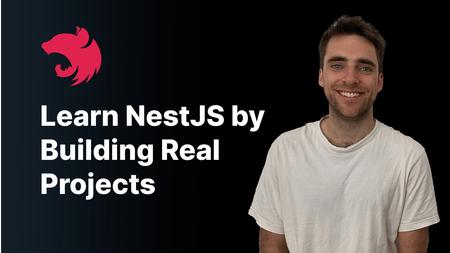English | MP4 | AVC 1920×1080 | AAC 44KHz 2ch | 60 Lessons (18h 20m) | 2.48 GB
Future-proof your career and increase your earning potential by following a comprehensive video-based course that ensures you master NestJS fundamentals and advanced concepts (even if you’re new to backend development).
Here’s exactly what you’ll learn
Through various projects and video-based lessons, you’ll learn the following techniques and concepts:
NestJS Fundamentals: Gain a solid foundation in NestJS concepts, architecture, and best practices. Learn how to set up a development environment, create modules, controllers, and services, and understand the core building blocks of a NestJS application.
Database Integration: Master the skills needed to persist data to a database and cache that seamlessly integrates into your NestJS code
Authentication and Authorization: Implement secure authentication and authorization mechanisms in your NestJS applications.
Real-World Projects: Apply your knowledge by building real-world projects that solve common backend challenges. Building a REST API with full CRUD functionality using NestJS Controllers, Middleware & Pipes
Queues: You’ll learn all about setting up queues to handle asynchronous operations like uploading files
Testing and Deployment: Learn best practices for testing your NestJS applications using tools like Jest and Supertest. Unit testing, integration testing & e2e testing are extensively covered!
CI/CD: Get familiar with working on production-grade projects by setting up CI/CD automation using Github Actions
By following this comprehensive curriculum, you’ll gain the skills and confidence to tackle any backend challenge and build impressive, real-world applications using NestJS
Table of Contents
1 Introduction & project preview
2 Project pre-requisites & set up
3 The NestJS lifecycle
4 Middleware
5 Guards
6 Interceptors (before handlers)
7 Pipes
8 Route handlers
9 Interceptors (after handlers)
10 Exception filters
11 Dependency Injection
12 E2e testing
13 CI/CD set up with Github Actions
14 Deployment with Railway
15 Introduction & project preview
16 Project set up
17 Adding a Core module with ConfigModule set up
18 Using an interceptor to enforce a consistent HTTP response structure
19 Security considerations (Helmet & validation pipes)
20 Setting up a custom Logger
21 Docker Compose set up for Postgres & Redis
22 Interacting with the database (using Prisma)
23 Interacting with the cache (using Redis)
24 Unit testing
25 Integration & e2e testing
26 Setting up the CI/CD pipeline
27 Deployment (with Railway)
28 Introduction & project preview
29 Project set up
30 Adding the CRUD endpoints
31 Business logic: creating a shortened URL
32 Business logic: redirecting a short URL
33 Business logic: Updating and deleting a short URL
34 Business logic: return list of saved short URLs
35 API key authentication
36 Unit testing
37 Integration testing
38 E2e testing
39 Deployment (with Railway)
40 Introduction & project preview
41 Project set up
42 Add logic for creating new real estate listings
43 Attach image files to HTTP request
44 Setting up the queue with Bull
45 Visualise the queue with Bull Board
46 Sending files to the queue for processing
47 Uploading the file to Google Cloud Storage
48 Storing a reference to the GCP image
49 Unit testing
50 Integration testing
51 E2E testing
52 Deployment (with Railway)
53 Introduction & project preview
54 Monorepo setup
55 Frontend setup
56 Authentication with Google
57 Implementing browser sessions with refresh tokens
58 Fetching the initial state with HTTP
59 Implementing a Websocket client & server
60 Deployment (with Railway)
Resolve the captcha to access the links!
